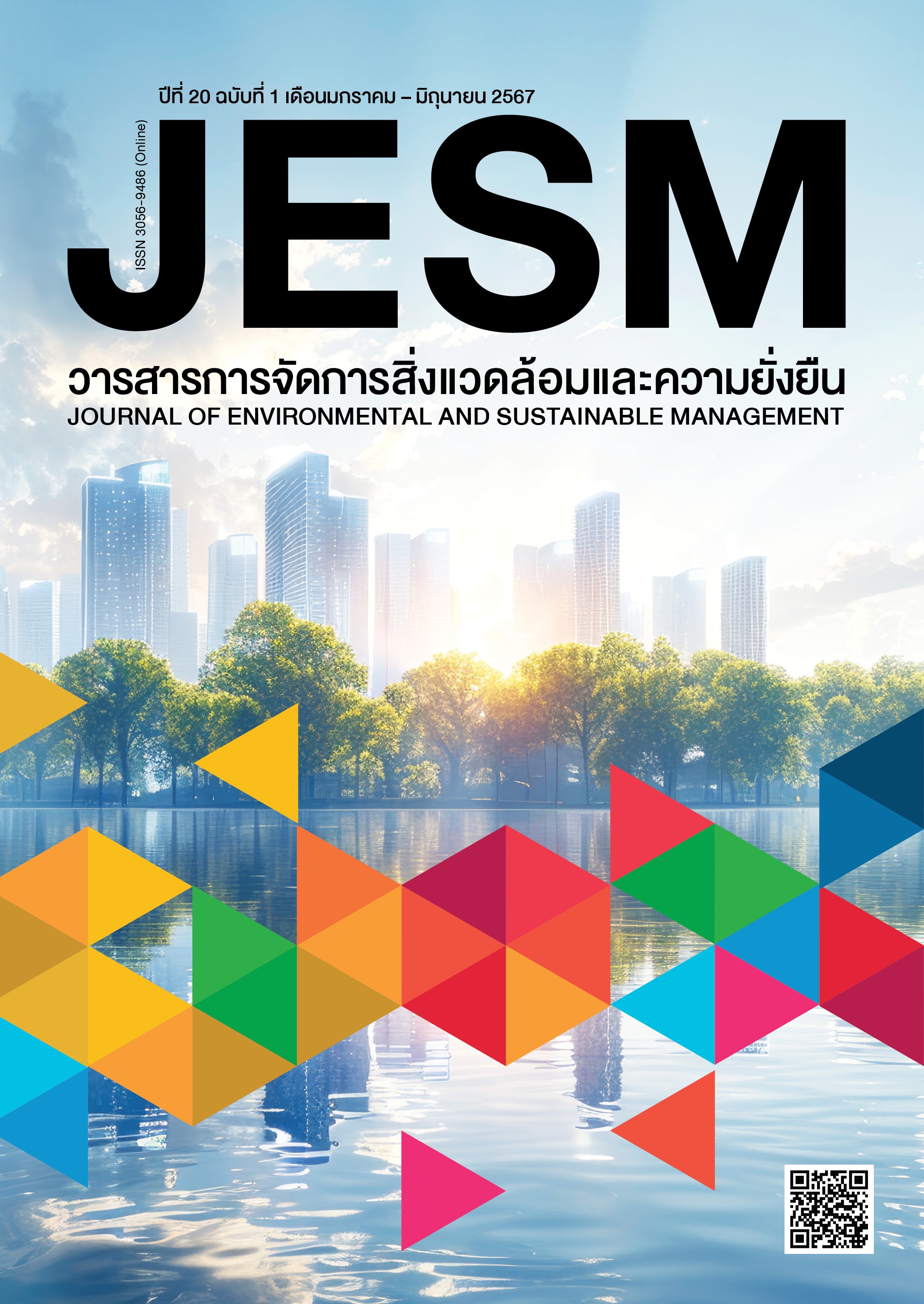ปริมาณ องค์ประกอบทางเคมีและแนวทางการใช้ประโยชน์ขยะอาหารจากร้านอาหารและบริการอาหาร: กรณีศึกษาในพื้นที่เทศบาลเมืองชะอำ จังหวัดเพชรบุรี และเทศบาลเมืองหัวหิน จังหวัดประจวบคีรีขันธ์
DOI:
https://doi.org/10.14456/jesm.2024.4คำสำคัญ:
ขยะอาหาร, ร้านอาหารและบริการอาหาร, องค์ประกอบทางเคมีบทคัดย่อ
การวิจัยนี้มีวัตถุประสงค์เพื่อศึกษาปริมาณและองค์ประกอบทางเคมีของขยะอาหารที่เกิดจากร้านอาหารและบริการอาหารในพื้นที่เทศบาลเมืองชะอำ จังหวัดเพชรบุรี และเทศบาลเมืองหัวหิน จังหวัดประจวบคีรีขันธ์ เก็บข้อมูลจากตัวอย่างร้านอาหารและบริการอาหารในช่วงสิงหาคม พ.ศ. 2564 - กรกฎาคม พ.ศ. 2565 ผลการศึกษา พบว่า ร้านอาหารและบริการอาหารในพื้นที่เทศบาลเมืองชะอำมีขยะอาหาร 1,130.86 ตันต่อปี และในพื้นที่เทศบาลเมืองหัวหิน 2,021.41 ตันต่อปี ส่วนใหญ่เป็นเศษอาหารเหลือจากการบริโภค (ร้อยละ 46.17 และ 42.08 ของขยะอาหารทั้งหมดในพื้นที่เทศบาลเมืองชะอำและเทศบาลเมืองหัวหิน ตามลำดับ) ถัดมาเป็นขยะอาหารที่สามารถนำไปใช้เป็นอาหารสัตว์ซึ่งส่วนใหญ่เป็นเศษเนื้อ นมและไข่ เศษอาหารทะเล รวมไปถึงเศษขนมปัง (ร้อยละ 29.46 และ 33.61 ตามลำดับ) และขยะอาหารที่เหมาะสำหรับใช้ทำปุ๋ยหมักซึ่งส่วนใหญ่เป็นเศษผักและผลไม้ (ร้อยละ 24.37 และ 24.31 ตามลำดับ) เศษปลาและเปลือกกุ้งมีโปรตีนสูงมีศักยภาพในการเป็นแหล่งโปรตีนในสูตรอาหารสัตว์ได้แต่ควรระวังเรื่องการปนเปื้อนแคดเมียมและปรอท กล่าวได้ว่า การคัดแยกขยะอาหารจากร้านอาหารและบริการอาหารที่ต้นทางตามคุณสมบัติและวิธีการนำไปใช้ประโยชน์นับเป็นการจัดการขยะอาหารที่ช่วยส่งเสริมความยั่งยืนของภาคการท่องเที่ยว
เอกสารอ้างอิง
Association of Official Analytical Chemists. (2016). Official Methods of Analysis (20th ed). Association of Official Analytical Chemists, Washington DC, USA.
Bray, R.H., & Kurtz, L.T. (1945). Determination of total organic and available forms of phosphorus in soil. Soil Science, 59(1), 39-45.
Cullere, M., Tasoniero, G., Giaccone, V., Miotti-Scapin, R., Claeys, E., De Smet, S., & Zotte, D.A. (2016). Black soldier fly as dietary protein source for broiler quails: apparent digestibility, excreta microbial load, feed choice, performance, carcass and meat traits. Animal, 10, 1923-1930.
Diener, S., Zurbrügg, C., Gutiérrez, F.R., Nguyen, D.H., Morel, A., Koottatep, T., & Tockner, K. (2011). Black soldier fly larvae for organic waste treatment-prospects and constraints. In Proceedings of the WasteSafe 2011 – 2nd International Conference on Solid Waste Management in the Developing Countries ,13-15 February 2011 (pp. 52(1-8)). Khulna, Bangladesh.
Economics Tourism and Sports Division, Ministry of Tourism and Sports. (2023). Domestic Tourism Statistics - Classify by region and province 2023 [in Thai]. Retrieved May 14, 2024, from https://www.mots.go.th/news/category/705.
Elkhalifa, S., Al-Ansari, T., Mackey, H.R., & McKay, G. (2019). Food waste to biochars through pyrolysis: A review. Resources, Conservation and Recycling, 144, 310-320.
Filimonau, V. & Uddin, R. (2021). Food waste management in chain-affiliated and independent consumers’ places: A preliminary and exploratory study. Journal of Cleaner Production, 319, Article 128721.
Guven, H., Wang, Z., & Eriksson, O. (2019). Evaluation of future food waste management alternatives in Istanbul from the life cycle assessment perspective. Journal of Cleaner Production, 239, 117999
International Organization for Standardization. (2009). ISO 5983-2: 2009. Animal feeding stuffs-Determination of nitrogen content and calculation of crude protein content-Part 2: Block digestion and steam distillation method.
Karaket, T., Seel-audom, M., & Yuangsoi, B. (2022). Partial replacement of fish meal with blood meal in diet on growth performance for nursing Red Tilapia (Oreochromis spp.). Burapha Science Journal, 27(2), 801-814.
Lertchunhakiat, K., Saenphoom, P., Nopparatmaitree, M., & Chimthong, S. (2016). Effect of eggshell as a calcium source of breeder cock diet on semen quality. Agriculture and Agricultural Science Procedia, 11, 137-142.
Lundie, S., & Peters, G.M. (2005). Life cycle assessment of food waste management options. Journal of Cleaner Production, 13(3), 275-286.
Melikoglu, M., Lin, C.S.K., & Webb, C. (2013). Analysing global food waste problem: pinpointing the facts and estimating the energy content. Central European Journal of Engineering, 3(2), 157-164.
Newton, L.A.R.R.Y., Sheppard, C.R.A.I.G., Watson, D.W., Burtle, G.A.R.Y., & Dove, R.O.B.E.R.T. (2005). Using the black soldier fly, Hermetia illucens, as a value-added tool for the management of swine manure. Animal and Poultry Waste Management Center, North Carolina State University, Raleigh, NC, 17.
Peech, M., Alexander, L.T., Dean, L.A., & Reed, J.F. (1947). Method of Soil Analysis for Soil Fertility Investigation. Washington: Government Printing Office, Department of Agriculture.
Safamehr, A., Lanille, M.I., Anderson, D.M., & MacIsaac, J.L. (2013). Evaluation of composition and in vitro solubility rate of by-products of the Atlantic shellfish industry as alternative calcium sources. Journal of Applied Poultry Research, 22(3), 529-538.
Sheppard, D.C., Tomberlin, J.K., Joyce, J.A., Kiser, B.C., & Sumner, S.M. (2002). Rearing methods for the black soldier fly (Diptera: Stratiomyidae). Journal of medical entomology, 39(4), 695-698.
Shukla, K.A., Sofian, A.D.A.B.A., Singh, A., Chen, W.H., Show, P.L., & Chan, Y.J. (2024). Food waste management and sustainable waste to energy: Current efforts, anaerobic digestion, incinerator and hydrothermal carbonization with a focus in Malaysia. Journal of Cleaner Production, 448,141457.
Surendra, K.C., Tomberlin, J.K., van Huis, A., Cammack, J.A., Heckmann, L.H.L., & Khanal, S.K. (2020). Rethinking organic wastes bioconversion: Evaluating the potential of the black soldier fly (Hermetia illucens (L.)) (Diptera: Stratiomyidae) (BSF). Waste Management, 117, 58-80.
Sustainable Restaurant Association. (2010). Too Good to Waste: Restaurant Food Waste Survey Report, SRA, London.
Teigiserova, D.A., Hamelin, L., & Thomsen, M. (2020). Towards transparent valorization of food surplus, waste and loss: Clarifying definitions, food waste hierarchy, and role in the circular economy. Science of the Total Environment, 706, 136033.
Tilman, D., & Clark, M. (2014). Global diets link environmental sustainability and human health. Nature, 515, 518–522.
Tilman, D., Balzer, C., Hill, J., & Befort, B.L. (2011). Global food demand and the sustainable intensification of agriculture. Proceedings of the National Academy of Sciences of the United States of America, 108, 20260–20264.
Undersander, D., Mertens, D.W., & Theix, N. (1993). Forage Analysis Procedures. National Forage Testing Association, Omaha, NE.
U.S. Environmental Protection Agency. (2002). Method 1631, Revision E: Mercury in Water by Oxidation, Purge and Trap, and Cold Vapor Atomic Fluorescence Spectrometry.
Winnow. (2018). Addressing Food Waste in the Hospitality & Foodservice Sector. An Overview of Why and Where Food Waste Happens Winnow Solutions, London.
Yamane, T. (1967). Statistics: An Introductory Analysis, 2nd Ed., New York: Harper and Row.



